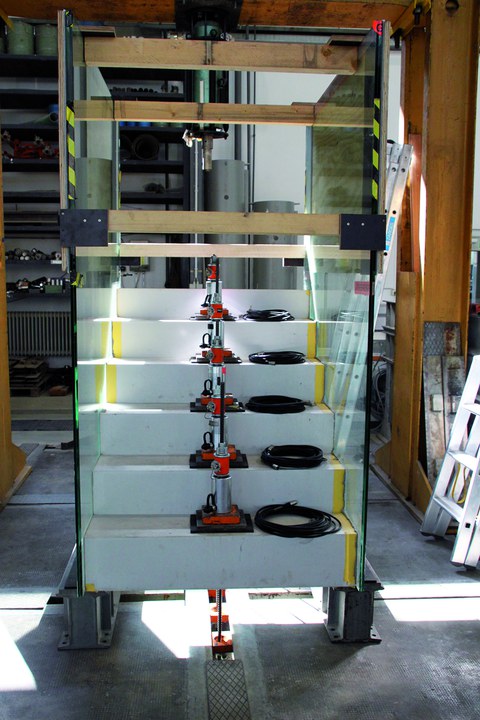Load test on a stair construction
Table of contents
Projektdaten
| Titel | Title Belastungsversuch an einer Treppenkonstruktion | Load test on a stairway structure Auftraggeber | Client Dyckerhoff AG Wiesbaden Zeitraum | Period 06.2011 – 11.2011 Leiter | Project manager Prof. Dr.-Ing. Dr.-Ing. E.h. Manfred Curbach Bearbeiter | Contributors Dr.-Ing. Frank Schladitz, Dipl.-Ing. Enrico Lorenz Projektdurchführung | Project executers Ludwig Beier, Tino Jänke, Heiko Wachtel, Andreas Thieme, Maik Patricny, Bernd Wehner |
Report from the yearbook 2011
Filigree staircase design under test

UHPC staircase in load test
Last year, Architekturzeitung posted: "Dyckerhoff AG is presenting a world first with its Dyckerhoff Weiss product brand at BAU 2011 in Munich. A self-supporting stair exhibit made of white, ultra-high-strength concrete and glass is the highlight at the 200 square meter booth. ...". The beautifully designed component really impressed visitors, but what was so special about it?
Dyckerhoff, like a number of other companies, has been developing ways and products to drive the easier use of innovative concretes in construction. In the case of the staircase, an ultra-high performance concrete (UHPC) was used. Among other features, UHPCs are characterized by a dense microstructure and a very high compressive strength, which can easily exceed 150 N/mm², making concrete an interesting building material even as a steel substitute. In addition, when fibers are added, UHPCs have increased tensile and flexural strength.
In order to demonstrate the performance of a new material to the public, demonstrator objects are often realized. This was also the case with this project, which was carried out in cooperation with Benno Drössler GmbH & Co. Bauunternehmung KG in Siegen, Germany. One stair section was a total of 1.15 m high and 1.08 m wide. The five stair treads were only 29 mm thick and bonded with an epoxy resin adhesive between two 20 mm thick glass stringers. In order to be able to integrate such a staircase into buildings, its load-bearing capacity must first be verified. Such a test has now been realized in the Otto Mohr Laboratory.
Each step was loaded centrally by a hydraulic press, which was anchored in the hall floor via tie rods. Deformations were measured with inductive displacement transducers and strain gauges at selected points. A total of almost 110 kN (equivalent to about 11 tons of weight) was introduced into the structure. This corresponds to a surface load of well over 70 kN/m², which is far above the surface loads normally applied to stairs and the like. The failure was finally caused by a fracture in the area of the adhesive joint to a glass stringer.
